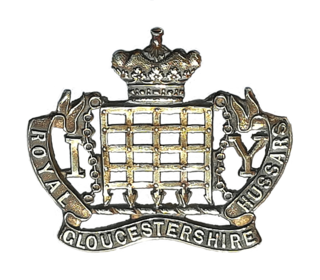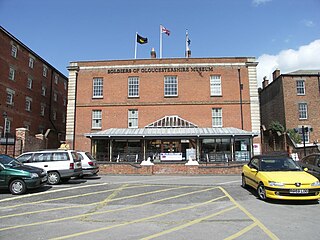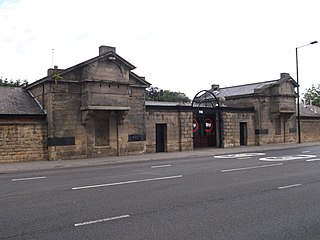Options for Change was a restructuring of the British Armed Forces in summer 1990 after the end of the Cold War.

The Royal Gloucestershire, Berkshire and Wiltshire Regiment was a short-lived infantry regiment of the British Army.

Horfield is a suburb of the city of Bristol, in southwest England. It lies on Bristol's northern edge, its border with Filton marking part of the boundary between Bristol and South Gloucestershire. Bishopston lies directly to the south. Monks Park and Golden Hill are to the west. Lockleaze and Ashley Down are on the eastern fringe. The Gloucester Road (A38) runs north–south through the suburb.

The Gloucestershire Regiment, commonly referred to as the Glosters, was a line infantry regiment of the British Army from 1881 until 1994. It traced its origins to Colonel Gibson's Regiment of Foot, which was raised in 1694 and later became the 28th Regiment of Foot. The regiment was formed by the merger of the 28th Regiment with the 61st Regiment of Foot. It inherited the unique distinction in the British Army of wearing a badge on the back of its headdress as well as the front, a tradition that originated with the 28th Regiment after it fought in two ranks back to back at the Battle of Alexandria in 1801. At its formation the regiment comprised two regular, two militia and two volunteer battalions, and saw its first action during the Second Boer War.

Cavalry Barracks is a former British Army installation located north of Hounslow Heath in Hounslow, west London. Hounslow was one of 40 new barracks established around the country in the wake of the French Revolution, to guard against the dual threats of foreign invasion and domestic sedition. The barracks later became a busy depot for the London military district. The barracks have been described by Historic England as 'one of the most significant and complete barracks in the country'; as of June 2021 the site is scheduled to be developed as a sustainable living project by Hounslow Council.
The 28th Regiment of Foot was a line infantry regiment of the British Army, raised in 1694. Under the Childers Reforms it amalgamated with the 61st Regiment of Foot to form the Gloucestershire Regiment in 1881.

The Royal Gloucestershire Hussars was a volunteer yeomanry regiment which, in the 20th century, became part of the British Army Reserve. It traced its origins to the First or Cheltenham Troop of Gloucestershire Gentleman and Yeomanry raised in 1795, although a break in the lineage means that its formation is dated to the Marshfield and Dodington Troop raised in 1830. Six further troops – officered by nobility and gentry, and recruited largely from among landholders and tenant farmers – were subsequently raised in Gloucestershire, and in 1834 they came together to form the Gloucestershire Yeomanry Cavalry. In 1847, the regiment adopted a hussar uniform and the name Royal Gloucestershire Hussars. Originally intended to counter insurrection and a French invasion that never materialised, the yeomanry's first deployments were ceremonial and as mounted police during times of civil unrest. Three Gloucestershire troops were deployed to Bristol on two separate occasions in the 1830s in support of the civil authorities.
The 61st Regiment of Foot was an infantry regiment of the British Army, raised in 1756. Under the Childers Reforms it amalgamated with the 28th Regiment of Foot to form the Gloucestershire Regiment in 1881.

The Special Reserve was established on 1 April 1908 with the function of maintaining a reservoir of manpower for the British Army and training replacement drafts in times of war. Its formation was part of the military reforms implemented by Richard Haldane, the Secretary of State for War, which also created the Territorial Force. Haldane originally intended that the Militia would provide the reserve, but opposition from its representatives forced him to abolish it and create the Special Reserve instead. Only 60 per cent of the Militia transferred into the new reserve, and it was consistently under strength, particularly in officers. Reservists enlisted for a six-year term of service, and had to undergo six months of basic training on recruitment and three to four weeks training annually.

The Soldiers of Gloucestershire Museum is located within the historic docks in the city of Gloucester. The museum tells the story of two regiments of the British Army, the Gloucestershire Regiment, including its antecedents the 28th Regiment of Foot and the 61st Regiment of Foot, and the Royal Gloucestershire Hussars, both of which recruited heavily from Gloucestershire and Bristol.

The regimental depot of a regiment is its home base for recruiting and training. It is also where soldiers and officers awaiting discharge or postings are based and where injured soldiers return to full fitness after discharge from hospital before returning to full duty. Normally, a variety of regimental stores will also be kept at the depot. The regimental depot is not the same as the regimental headquarters, though in practice the two will often be co-located in the same place.

Fenham Barracks is a military installation in Barrack Road, Newcastle upon Tyne, Tyne and Wear, England.

Fulwood Barracks is a military installation at Fulwood in Preston, Lancashire, England. It is set to close in 2030.

Warley Barracks was a military installation at Warley near Brentwood in Essex.

Hightown Barracks is a military installation in Wrexham, Wales.

Ladysmith Barracks was a British military installation on Mossley Road, Ashton-under-Lyne, Greater Manchester.

The Regiment "Cavalleggeri di Treviso" (28th) is an active cavalry unit of the Italian Army. The regiment was formed by the Royal Italian Army in 1909 and active during World War I on the Italian Front. Even though the regiment had earned a Silver Medal of Military Valor in the Battle of Monfalcone in 1916 it was disbanded after the war. The regiment was active again during the Cold War between 1975 and 1991. The unit's name, flag and traditions were assigned on 4 October 2022 to the Command and Tactical Supports Unit "Pozzuolo del Friuli" of the Cavalry Brigade "Pozzuolo del Friuli".
The Gloucestershire Militia was a part-time military force in the county of Gloucestershire in the West of England. From their formal organisation as Trained Bands in 1558 until their final service as a Special Reserve unit of the Gloucestershire Regiment in World War I, the Militia regiments of the county served in home defence in all of Britain's major wars.
The Royal South Gloucestershire Light Infantry (RSGLI), later the 3rd Battalion, Gloucestershire Regiment was a Militia regiment raised in the county of Gloucestershire in the West of England. From its formal creation in 1759 the regiment served in home defence in all of Britain's major wars until 1918.
The Royal North Gloucestershire Militia (RNGM), later the 4th (Militia) Battalion, Gloucestershire Regiment was a Militia regiment raised in the county of Gloucestershire in the West of England. From its formal creation in 1763 the regiment served in home defence and overseas garrisons in all of Britain's major wars until 1908.















